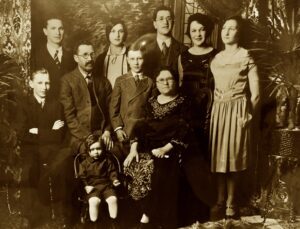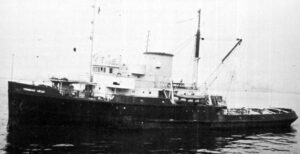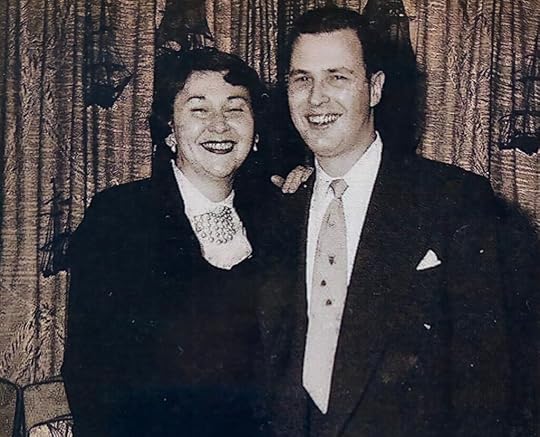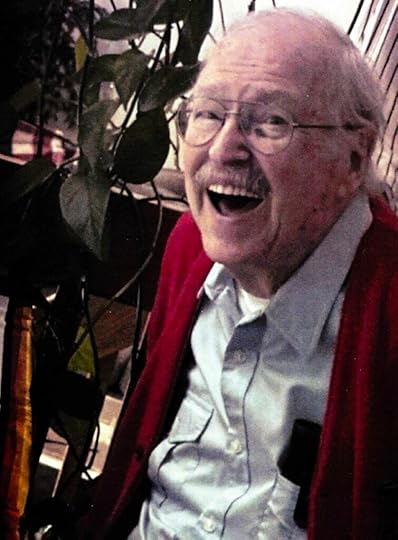Radio Telegraph Operator Second Class Leon Schiff, U.S. Merchant Marine – A Will to Serve During World War II
After the United States entered World War II, the American public rallied behind the war effort. Everyone contributed by recycling metals, accepting shortages of consumer goods so war materials could be produced instead, and buying war bonds. Even more significant, millions of men volunteered to serve in the armed forces. Yet not all who wanted to serve in the military could. Some had crucial jobs in agriculture and industry, so they could not be released to serve. Others like Radio Telegraph Operator Second Class Leon Schiff faced different barriers. Leon was so nearsighted, the military would not allow him to volunteer. Undeterred and committed to doing his part to bring about the defeat of Germany and Japan, Leon volunteered in 1944 to serve in the U.S. Merchant Marine—an underappreciated yet crucial component of the Allied victory in the war.
Leon was born in East Boston, Massachusetts, in 1925. He was the youngest of ten children and the son of a butcher. His father immigrated to the United States from England in 1903 after the London smog started causing him health problems. He sent for Leon’s mother and three older brothers in 1905 after he established himself in Boston and saved enough money for their passage. Leon’s remaining six brothers and sisters were quite literally born in their new home in the United States—Leon was the first and only one of the siblings born in a hospital.
After completing the ninth grade, Leon attended East Boston High School for his sophomore through senior years. Instead of gym class, he and the other boys participated in troop training. They even donned surplus World War I uniforms and joined boys from other schools marching through Boston to demonstrate their martial skills. Outside of school, Leon worked as a “soda jerk” at local pharmacy stores owned by his older brothers. During the summers, he took his skills to Winthrop and Revere Beach, where he worked with other boys serving soft drinks to people in dance halls taking refreshment breaks between songs.
 Leon Schiff (small boy in bottom center) with his parents and seven of his brothers and sisters
Leon Schiff (small boy in bottom center) with his parents and seven of his brothers and sistersLeon turned seventeen in May 1942 and graduated from high school the following month. With the nation mobilizing in the wake of the Japanese attack on Pearl Harbor just seven months before, Leon’s first inclination was to enlist in the military. Unfortunately, he was very nearsighted, so the Army, Navy, and Coast Guard could not accept him. Upset but not discouraged, Leon attended Temple University in Philadelphia during the fall of 1942 and the spring of 1943 before hitchhiking to Canada to join the Canadian army to get into the fight. Again, he was thwarted because he did not want to risk losing his U.S. citizenship by taking an oath to Canada in order to enlist. Accordingly, he returned to Temple University for the 1943–44 academic year.
In the spring of 1944, Leon learned there was another way he could serve—the U.S. Merchant Marine. Merchant Marine civilian mariners manned the ships carrying millions of tons of supplies across the submarine-infested Atlantic and Pacific sea lanes to where they were needed most by the Allied forces fighting Germany and Japan. Closer to home, they manned the coastal freighters transporting goods between U.S. ports, always subject to the danger posed by German U-boats hunting them off America’s east coast.
Leon applied to the Merchant Marine in the late spring of 1944 and was accepted. He reported for boot camp at the U.S. Maritime Service’s training station at Sheepshead Bay in Brooklyn, New York, immediately adjacent to the Coast Guard training station at Manhattan Beach. There he learned the basics of seamanship, including tying knots, ship driving, navigation, engineering, and cargo handling. He also took aptitude tests to see what positions he might be best suited for, such as cook, baker, engine room wiper or oiler, steward, hospital corpsman, or radio operator.
Based on Leon’s test results, he was selected to train as a radio operator. Accordingly, after completing boot camp, he and the other radio operator selectees were transferred to Gallops Island in Boston Harbor to attend radio operator school for twenty weeks. During the first week, Leon’s platoon of twenty men was assigned drudge work like cooking, cleaning, disposing of garbage, and performing other similar tasks. After a week of paying their dues, they began their formal radio operator training, joining two other platoons that had been training there for some time.
The schedule at Gallops Island was rigorous. Reveille woke Leon at 6:00 a.m. every weekday, followed by breakfast and exercise. Classes in radio theory and Morse code began at 8:00 a.m. and continued until 4:00 p.m., with a one-hour break for lunch. Every Friday, Leon and his classmates were tested on the week’s course material. If they failed, they repeated the week’s courses and retook the test at the end of the next week. If they failed a second time, they were dropped from radio operator training and returned to boot camp at Sheepshead Bay. To keep that from happening, the men helped each other learn the material in study sessions after the end of each workday. As a result, few failed the weekly tests.
 The Sands Point was a powerful V4-M-A1 tug built in 1943. This photo is of the Trinidad Head, a similar V4-M-A1 tug. Source: U.S. Navy
The Sands Point was a powerful V4-M-A1 tug built in 1943. This photo is of the Trinidad Head, a similar V4-M-A1 tug. Source: U.S. NavyLeon was fortunate in that he excelled in both the radio theory course material and Morse code. Of the two, learning Morse code was more difficult because it was a skill some men had a knack for, and others didn’t. To successfully complete the training and earn his Federal Communications Commission (FCC) Second Class Radio Operator’s License, Leon had to be able to transmit and receive thirty words per minute, where a word consisted of a group of five short signals of light or sound. Leon caught on quickly because he recognized a rhythm in the transmissions, allowing him to increase his Morse code speed every week. He also had good role models in his instructors, who could send and receive up to sixty words per minute, so Leon knew thirty words per minute was certainly achievable.
By about the fifteenth week of the training, Leon had mastered the radio theory material and could send and receive over thirty words per minute in Morse code. Accordingly, he asked to take the next Monday off so he could take the Second Class Radio Operator’s License exam at the FCC office in Boston. When his instructors denied his request, Leon took matters into his own hands. The following Friday, he took the liberty boat to Boston and instead of returning to Gallops Island on Sunday morning as he was required to do, he stayed in Boston and took the FCC licensing exam on Monday. He then returned to the island on Monday afternoon.
Although Leon passed the exam and earned his Second Class Radio Operator’s License, he had defied his instructors and had to be held accountable. Accordingly, he was disciplined at an administrative procedure known as captain’s mast. His sanction was he had to take additional classes at night after the workday had ended, but Leon considered this a small price to pay now that he had his FCC license in hand.
Leon’s timing could not have been better. With the end of World War II on the horizon, the U.S. Maritime Service stopped sending radio operator trainees to Gallops Island. Leon and the other students were then transferred first to the radio operator training facility on Hoffman Island, near Staten Island, New York, and then back to the main training facility at Sheepshead Bay in Brooklyn. An announcement followed that all radio telegraph operator trainees would be transferred to ships to serve as messmen, but Leon objected. He argued that since he already had his FCC license, he qualified to be assigned as a radio telegraph operator second class, which would make him a junior officer rather than an unlicensed seaman. The training staff agreed and, in May 1945, sent him to New Orleans shortly after Victory in Europe (VE) Day. There he joined the crew of the 186-foot seagoing tug Sands Point. The tug, which was built for the U.S. Navy in 1943 and operated by the Moran Towing Company under contract, had a crew of eighteen. As a radio telegraph operator second class, Leon was one of five officers onboard. The others were the captain, the first mate, the chief engineer, and the first assistant engineer.
As the Sands Point’s radio telegraph operator, Leon had his own stateroom, located immediately behind the tug’s radio room. This allowed him to be ready to send or receive radio messages at any time of the day or night, even when he wasn’t on watch. He also had to maintain the radio’s six large batteries, which powered the generator that ran the tug’s radio. Despite these responsibilities, Leon was called upon only three times to use his hard-earned Morse code skills. The most notable time involved the captain calling him to the pilot house to decipher a message a U.S. Army transport ship was sending using a flashing light. When Leon decoded the signals, he learned the crew of the Army transport did not know what their position was and was asking the Sands Point to tell them where they were. After Leon answered by providing the Army transport’s position, the Sands Point continued on its way.
Aside from the infrequent radio telegraph responsibilities, Leon’s principal duties involved standing watch in the tug’s pilot house and assisting the rest of the crew accomplish the tug’s towing missions. These missions primarily involved assisting tankers experiencing problems in the Gulf of Mexico as they ferried oil from Venezuela to the United States. The Sands Point rendezvoused with them wherever they broke down and towed them to a U.S. port on the Gulf Coast for repairs.
 Leon and Eileen Schiff
Leon and Eileen SchiffLater that year, Leon and the Sands Point relocated to Galveston, Texas. In addition to continuing with its previous towing duties, it began making trips to the Wainwright Shipyard in Panama City, Florida, where it picked up new tankers that were no longer needed now that World War II was over. The Sands Point towed these tankers to Beaumont, Texas, and pushed them onto the mud flats for storage. The tankers were later sold at auction for pennies on the dollar to businessmen like Aristotle Onassis, who used them to build his postwar shipping empire.
Another postwar mission of the Sands Point involved towing cargo ships loaded with World War II surplus aircraft and vehicles into the deepwater areas of the Gulf of Mexico. Rather than selling the surplus items in the United States where they would flood the market, the U.S. government disposed of the items by shoving them overboard into the deepest part of the Gulf. The empty cargo ships were then towed to Beaumont’s mud flats, where they joined the tankers waiting to be auctioned off to the highest bidders.
Unlike on most ships, one highlight of life on the Sands Point was the food. Sometimes when the tug left Galveston, the cook would throw a net overboard to catch enough shrimp to feed the crew. Other fresh seafood was also plentiful, as were bacon and eggs and other staples. Even better, meals were available twenty-four hours a day. Aside from the food, Leon enjoyed sunning in the former gun mount tub on top of the pilot house and studying to become a pharmacist in hopes of following in his brothers’ footsteps. Rounding out his experience at sea, Leon only got seasick once when the tug rode out a hurricane in the deep water of the Gulf of Mexico. He felt sorry for the seamen that had to clean up the mess.
At the end of December 1945, Leon decided that since the war was over, it was time to go home. He returned to Boston and to his job working for his brothers at their pharmacies. He also took some pharmacy courses to prepare for the pharmacy exam. In 1947, his studying paid off when he passed the pharmacy exam and became a licensed pharmacist. That same year, he married, Eileen, his wife of sixty-three years before she passed away. Together they had a son, Jeff, and two daughters, Nancy and Lisa. Leon also eventually bought his brothers’ pharmacies and expanded to more locations in Boston until he finally got out of the pharmacy business in 1981. Now he is retired and living with one of his daughters on the Atlantic coast northeast of Boston.
Voices to Veterans is proud to salute Radio Telegraph Operator Second Class Leon Schiff for his service in the U.S. Merchant Marine during World War II. Undeterred when doors closed to service in the military, Leon volunteered to serve on the ships supplying U.S. and Allied forces worldwide in their efforts to defeat the Axis. After many months of training, his service took him to the Gulf of Mexico, where he assisted ships at risk and enabled the U.S. postwar drawdown. We thank him for his service and wish him fair winds and following seas.
If you enjoyed Leon’s story, please sign up for the Voices to Veterans Spotlight monthly newsletter by clicking here. Once each month, you’ll receive a new written veteran’s story directly in your mailbox. Best of all, it’s free and you can unsubscribe at any time.
 Leon Schiff
Leon Schiff The post Radio Telegraph Operator Second Class Leon Schiff, U.S. Merchant Marine – A Will to Serve During World War II first appeared on David E. Grogan.



